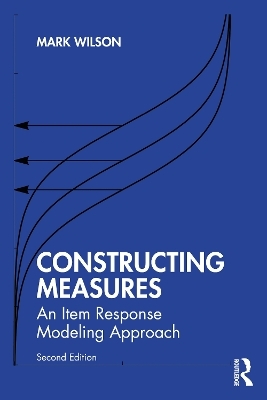
Constructing Measures
An Item Response Modeling Approach
Seiten
2023
|
2nd edition
Routledge (Verlag)
978-1-032-26166-9 (ISBN)
Routledge (Verlag)
978-1-032-26166-9 (ISBN)
Constructing Measures, Second Edition introduces a way to understand the advantages and disadvantages of measurement instruments, how to use such instruments, and how to apply these methods to develop new instruments or adapt old ones, based on item response modeling and construct references.
Constructing Measures introduces a way to understand the advantages and disadvantages of measurement instruments. It explains the ways to use such instruments, and how to apply these methods to develop new instruments or adapt old ones, based on item response modeling and construct references.
Now in its second edition, this book focuses on the steps taken while constructing an instrument, and breaks down the "building blocks" that make up an instrument—the construct map, the design plan for the items, the outcome space, and the statistical measurement model. The material covers a variety of item formats, including multiple-choice, open-ended, and performance items, projects, portfolios, Likert and Guttman items, behavioral observations, and interview protocols. Each chapter includes an overview of the key concepts, related resources for further investigation, and exercises and activities. A variety of examples from the behavioral and social sciences and education—including achievement and performance testing, attitude measures, health measures, and general sociological scales—demonstrate the application of the material. New to this edition are additional example contexts including a cognitive/achievement example, an attitude example, and a behavioral example and new concentrations on specific measurement issues and practices such as standard-setting, computer-delivery and reporting, and going beyond the Likert response format.
Constructing Measures is an invaluable text for undergraduate and graduate courses on item, test, or instrument development; measurement; item response theory; or Rasch analysis taught in a variety of departments, including education, statistics, and psychology. The book also appeals to practitioners who develop instruments, including industrial/organizational, educational, and school psychologists; health outcomes researchers; program evaluators; and sociological measurers.
Constructing Measures introduces a way to understand the advantages and disadvantages of measurement instruments. It explains the ways to use such instruments, and how to apply these methods to develop new instruments or adapt old ones, based on item response modeling and construct references.
Now in its second edition, this book focuses on the steps taken while constructing an instrument, and breaks down the "building blocks" that make up an instrument—the construct map, the design plan for the items, the outcome space, and the statistical measurement model. The material covers a variety of item formats, including multiple-choice, open-ended, and performance items, projects, portfolios, Likert and Guttman items, behavioral observations, and interview protocols. Each chapter includes an overview of the key concepts, related resources for further investigation, and exercises and activities. A variety of examples from the behavioral and social sciences and education—including achievement and performance testing, attitude measures, health measures, and general sociological scales—demonstrate the application of the material. New to this edition are additional example contexts including a cognitive/achievement example, an attitude example, and a behavioral example and new concentrations on specific measurement issues and practices such as standard-setting, computer-delivery and reporting, and going beyond the Likert response format.
Constructing Measures is an invaluable text for undergraduate and graduate courses on item, test, or instrument development; measurement; item response theory; or Rasch analysis taught in a variety of departments, including education, statistics, and psychology. The book also appeals to practitioners who develop instruments, including industrial/organizational, educational, and school psychologists; health outcomes researchers; program evaluators; and sociological measurers.
Mark Wilson is a Distinguished Professor at the University of California, Berkeley, who specializes in measurement and statistics. His research focuses on the establishment of a framework for measurement practice informed by the philosophy of measurement, on statistical models that are aligned with scientific models of the construct, and on instruments to measure new constructs.
1. The BEAR Assessment System: Overview of the "4 Building Blocks" approach 2. Construct Maps 3. The Items Design 4. The Outcome Space 5. The Wright Map 6. Evaluating and Extending the Statistical Model 7. Trustworthiness, Precision and Reliability 8. Trustworthiness, Validity and Fairness 9. Building on the Building Blocks. 10. Beyond the Building Blocks
| Erscheinungsdatum | 17.07.2023 |
|---|---|
| Zusatzinfo | 16 Tables, black and white; 10 Line drawings, color; 85 Line drawings, black and white; 4 Halftones, black and white; 99 Illustrations, black and white |
| Verlagsort | London |
| Sprache | englisch |
| Maße | 152 x 229 mm |
| Gewicht | 889 g |
| Themenwelt | Geisteswissenschaften ► Psychologie ► Allgemeine Psychologie |
| Geisteswissenschaften ► Psychologie ► Test in der Psychologie | |
| Sozialwissenschaften ► Pädagogik | |
| ISBN-10 | 1-032-26166-8 / 1032261668 |
| ISBN-13 | 978-1-032-26166-9 / 9781032261669 |
| Zustand | Neuware |
| Informationen gemäß Produktsicherheitsverordnung (GPSR) | |
| Haben Sie eine Frage zum Produkt? |
Mehr entdecken
aus dem Bereich
aus dem Bereich
Techniken der Verhaltenstherapie
Buch (2024)
Julius Beltz GmbH & Co. KG (Verlag)
CHF 48,95


